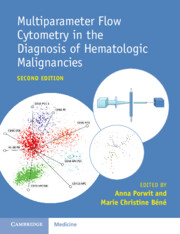Book contents
- Multiparameter Flow Cytometry in the Diagnosis of Haematologic Malignancies
- Multiparameter Flow Cytometry in the Diagnosis of Haematologic Malignancies
- Copyright page
- Contents
- Contributors
- Preface
- Abbreviations
- Chapter 1 Flow Cytometry in Clinical Haematopathology
- Chapter 2 Antigens
- Chapter 3 Flow Cytometry of Normal Blood, Bone Marrow and Lymphatic Tissue
- Chapter 4 Reactive Conditions and Other Diseases Where Flow Cytometric Findings May Mimic Haematological Malignancies
- Chapter 5 Examples of Immunophenotypic Features in Various Categories of Acute Leukaemia
- Chapter 6 Acute Lymphoid Leukaemia and Minimal/Measurable Residual Disease
- Chapter 7 Immunophenotyping of Mature B-Cell Lymphomas
- Chapter 8 Plasma Cell Myeloma and Related Disorders
- Chapter 9 Mature T-Cell Neoplasms and Natural Killer-Cell Malignancies
- Chapter 10 Flow Cytometric Diagnosis of Classic Hodgkin Lymphoma in Lymph Nodes
- Chapter 11 Measurable Residual Disease in Acute Myeloid Leukaemia
- Chapter 12 Ambiguous Lineage and Mixed Phenotype Acute Leukaemia
- Chapter 13 Flow Cytometry in Myelodysplastic Syndromes
- Chapter 14 Future Applications of Flow Cytometry and Related Techniques
- Index
- References
Chapter 7 - Immunophenotyping of Mature B-Cell Lymphomas
Published online by Cambridge University Press: 30 January 2025
- Multiparameter Flow Cytometry in the Diagnosis of Haematologic Malignancies
- Multiparameter Flow Cytometry in the Diagnosis of Haematologic Malignancies
- Copyright page
- Contents
- Contributors
- Preface
- Abbreviations
- Chapter 1 Flow Cytometry in Clinical Haematopathology
- Chapter 2 Antigens
- Chapter 3 Flow Cytometry of Normal Blood, Bone Marrow and Lymphatic Tissue
- Chapter 4 Reactive Conditions and Other Diseases Where Flow Cytometric Findings May Mimic Haematological Malignancies
- Chapter 5 Examples of Immunophenotypic Features in Various Categories of Acute Leukaemia
- Chapter 6 Acute Lymphoid Leukaemia and Minimal/Measurable Residual Disease
- Chapter 7 Immunophenotyping of Mature B-Cell Lymphomas
- Chapter 8 Plasma Cell Myeloma and Related Disorders
- Chapter 9 Mature T-Cell Neoplasms and Natural Killer-Cell Malignancies
- Chapter 10 Flow Cytometric Diagnosis of Classic Hodgkin Lymphoma in Lymph Nodes
- Chapter 11 Measurable Residual Disease in Acute Myeloid Leukaemia
- Chapter 12 Ambiguous Lineage and Mixed Phenotype Acute Leukaemia
- Chapter 13 Flow Cytometry in Myelodysplastic Syndromes
- Chapter 14 Future Applications of Flow Cytometry and Related Techniques
- Index
- References
Summary
This chapter provides useful guidelines for the immunophenotypic identification of both indolent and aggressive B-cell lymphomas. An integrated diagnostics is necessary to provide the final classification, but flow cytometry allows for a quick orientation about the lymphoma subtype and may help in speeding targeted further assays and therapeutic decisions.
Keywords
- Type
- Chapter
- Information
- Publisher: Cambridge University PressPrint publication year: 2025

